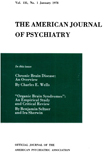PSYCHOTIC VISITORS TO THE WHITE HOUSE
Abstract
This study described a group of patients who, with few exceptions, were hospitalized after attempting to see the President at his official residence, the White House.
In 1943, Dr. Jay L. Hoffman reported his survey of psychotic visitors to government offices which included 55 cases in the years 1927 and 1937, but only 28 of these were visitors to the White House. Most came to Washington to seek relief from persecution (21 cases). Dr. Hoffman suggested that the personality of the presidential incumbent and the current problems of the government influenced the type of patient and the number of patients hospitalized. He also considered them "the most potentially dangerous of all patients."
To test these hypotheses, the charts of the 40 White House cases admitted to D.C. General Hospital in 1960 and 1961 were reviewed. In 1960, when Mr. Eisenhower was President, only nine patients were admitted, but 32 were hospitalized in 1961, Mr. Kennedy's inaugural year. This would suggest that some personal characteristic of the President was important.
Finally, ten White House cases were seen in psychiatric interviews between October 1, 1963 and January 1, 1964, and all ten cases were briefly summarized. In general, the more recent White House cases were quite similar to the patients of 20 years ago.
Based on the preceding data, the factors affecting the admission rate were discussed. The person of the President was important in some way. The surprisingly high number of foreign-born patients suggested a cultural determinant, although this could have been a function of the screening procedures by the Secret Service. To persist in trying to see the President, to give a history of previous mental illness and to be foreign-born were factors consistently found in the data.
Finally, "centrality," "need for validation" and "pseudo-community"—concepts which have been proposed in recent publications about paranoid states—were discussed in relation to this specialized group of patients. In the opinion of the authors, none of these hospitalized patients represented a special threat to the life of the President, whom they incorporated as a benevolent and necessary agent in a paranoid pseudo-community.
Access content
To read the fulltext, please use one of the options below to sign in or purchase access.- Personal login
- Institutional Login
- Sign in via OpenAthens
- Register for access
-
Please login/register if you wish to pair your device and check access availability.
Not a subscriber?
PsychiatryOnline subscription options offer access to the DSM-5 library, books, journals, CME, and patient resources. This all-in-one virtual library provides psychiatrists and mental health professionals with key resources for diagnosis, treatment, research, and professional development.
Need more help? PsychiatryOnline Customer Service may be reached by emailing [email protected] or by calling 800-368-5777 (in the U.S.) or 703-907-7322 (outside the U.S.).



